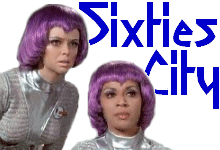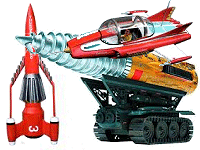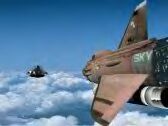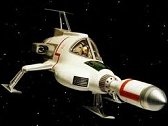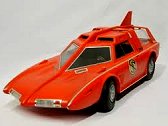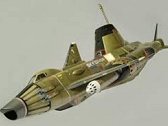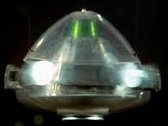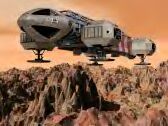|
|
|
1954 Devil Girl From Mars
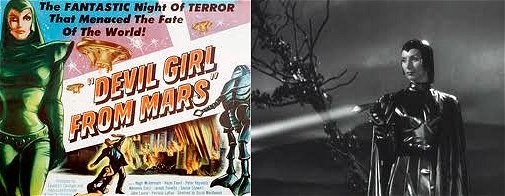
Sound editor (as
Gerald Anderson)
1955 You've Never Seen This
Polytechnic
Films
No
image available
Directed
by Gerry Anderson
A 3-part pilot television
series that featured people doing strange things or with unusual
talents, featuring three items from Belgium - The art of `Tapis
de Sable' (sand painting) and the artist Pierre van Ransbeck; A
cyclist attempting to beat the cycling land speed record of 109
mph and an 8ft tall man showing Peter Collins (the producer) the
sights of Brussels. It was made for possible sale to the Independent
Television Network. Polytechnic films was based at Taplow, Bucks.
and went into liquidation in 1957. The series was never shown and
so the title became a self-fulfilling prophecy. From Polytechnic,
AP Films was born, comprising of five members of Polytechnic: Gerry
Anderson, Arthur Provis, Reg Hill, John Read and Sylvia Thamm.

1956
Kellogg's Cornflakes
Pentagon Films
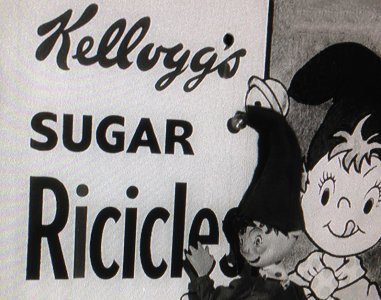
Director: Gerry Anderson (uncredited)
Director of Photography: Arthur Provis (uncredited)
Camera Operator: John Read (uncredited) Art
Director: Reg Hill (uncredited)
One
episode only, which featured the puppet character Noddy to advertise
Kelloggs Sugar Ricicles breakfast cereal, made
at Pentagon's
Berry Hill studio using the original puppets

1957
- Martin Kane - Private Investigator (Private Eye)
Towers
of London / Ziv TV / ABC

39
x b/w 30min episodes Transmitted:
1958 - 59
Produced by Harry Alan Towers
Some episodes
directed by Gerry Anderson (no other information)
Starring William Gargan and Brian Reece and originally titled
'The New Adventures of Martin Kane'
Martin Kane (Gargan),
a New York private detective, assists Scotland Yard Superintendent
Page (Reece) from his London Base, in the classic 'cops and robbers'
style.
Made at the Associated British Pathe Company studios at Elstree.
 
1957 - The Adventures of Twizzle
Produced by AP FILMS for Rediffusion
Television

52 x b/w 15min episodes First
transmitted: 13th November 1957
Created and written by Roberta
Leigh Directed by Gerry Anderson
Art Director: Reg Hill
Twizzle
is a lost boy doll who lives in a place called Straytown with all
the other lost or unwanted toys including his friends Footso, the
black cat, Candy Floss, Jack-in-the-box and Jiffy the broomstick man.
They are looked after by the Toy Inspector. Twizzle has the strange
ability to be able to stretch his arms and legs to incredible lengths.
It
is largely for Gerry Anderson's direction that the series is remembered,
even though he contributed to only the first 26 episodes. Made
at Islet Park studio on a budget of £450 per episode. 'Video
assist' first used in this series, allowing production crew other
than the cameraman to be able to see the shot in progress, a technique
soon widely adopted by the industry.
Sylvia Anderson recalls
“we did not all dote on puppets as children and have puppet theatre:
the raw truth is that we needed the work and that is all there was
on offer.”
Twizzle
And Footso
Twizzle And Footso Get Caught
Twizzle Saves The Doll
The Breakdown Van
Footso Is Stolen
Twizzle And The Golliwog
Jiffy And Chawky Quarrel
Footso Disappears
Twizzle And The Broken-Down Toy
Twizzle Builds Stray Town
A Flag For Stray Town
Jiffy's New House
Twizzle And Footso Go Fruit Picking
|
Twizzle
Has Some Fun
Twizzle And Candy Floss Open A Cake Shop
Twizzle Saves The Broken-Down Toys
Twizzle Gets Lost
Jiffy Opens A Barber Shop
Another Racing Car
Twizzle And His Friends Go To The Circus
The Toys Go To School
Bouncy The Ball
Jack-In-The-Box
Twizzle Catches Cold
The Naughty Girl
Jiffy's New Twigs |
Twizzle
And The Snowman
Twizzle And The Thin Teddy Bear
The Lazy Broomstick Man
Twizzle And The Polly Moppet
Footso And The Magic Seeds
Jiffy And The Polly Moppet Quarrel
Footso Gets A New Tail
Twizzle Is Naughty
Twizzle Is Stolen
Chawky Gets A Present
Twizzle And The Toy Inspector
Twizzle And The Naughty Breakdown Van
Orange And The Banana Tree |
Jiffy's
Birthday
Polly Moppet Disappears
Naughty Polly Moppet
Footso And The Naughty Girl
Stray Town Thief
Twizzle Papers The Cabin
Twizzle And Footso Go Camping
Twizzle Goes To The Seaside
Twizzle Goes To The Fair
Twizzle Goes Fishing
Twizzle Goes To The Zoo
Candy Floss's Birthday
Footso Has A Toothache |

1960 - Torchy the Battery Boy
Produced by AP FILMS
for Pelham Productions Limited

2 series of 26 x b/w
15 min episodes First transmitted: 23rd February
1960
Created and written
by Roberta Leigh Series One directed by Gerry Anderson
Torchy,
a clockwork toy with a battery-powered light on his hat, travels
in his space rocket to and from Topsy-Turvy Land, where all the
neglected and mistreated toys live and come alive to join in his
adventures.
Other characters included Mr Bumble-Drop, King Dithers, Bossy Boots,
Pom Pom, Flopsy, Pilliwig, Sparky, Squish and Pongo.
3-Dimensional
sets were introduced for the first time on this series and puppets
were fitted with moving mouths and eyes. Roberta Leigh went on to
make a second series of Torchy with Associated British Pathe.
Series One
Pom-Pom And The Toys
Topsy Turvy Land
Torchy And Squish
The Building Of Frutown
Torchy And The Broken Rocket
King Dithers
Torchy Goes Back To Earth
Bossy Boots Goes To Topsy Turvy Land
Bossy Boots Is Taught A Lesson
A Bell For A Penny Farthing
A Trick On Pom-Pom
Torchy Is Stolen
King Dithers Loses His Crown
|
Pilliwig Gets A Present
Bad Boy Bogey
Torchy And The Strange Animal
Bossy Boots Forgets To Be Good
Hungry Money Box
The Naughty Twins
The Twins Learn A Lesson
King Dithers Goes Down To Earth
Torchy Escapes At Last
Torchy And The Man In The Moon
Bogey And The Statues
The Moon Falls Asleep
Torchy's Birthday |
Series Two
Flopsy Goes On A Picnic
Torchy Gets A Surprise
Banana Bridge
King Dithers And Daffy
The Toys Get The Collywobbles
Bogey Learns Another Lesson
The Pollikan Bird Is Stolen
Torchy Has An Accident
Sparky The Dragon
Bogey Is Naughty Again
Pilliwig Cleans The Chimney
Pongo The Pirate
Pongo And The Gold Mine
|
King Dithers' Birthday
Washing Day In Topsy Turvy Land
Gluebell Wood
Squish Falls Down A Well
Flopsy In Trouble
The Big Storm
Daffy's Birthday
Flopsy Makes A Christmas Pudding
Gilly Golly In Trouble
King Bumble Drop
A New Suit For Pilliwig
The Obstinate Donkey
Pom-Pom Gets The Hiccups |

1960 - Four Feather Falls
Produced by AP FILMS
for Granada Television

39 x b/w 15 min episodes First
transmitted: 26th February 1960
Created by Barry
Gray Directed by Gerry Anderson
Sherrif
Tex Tucker saves the life of Makooya, the son of indian chief Kalamakooya
and is rewarded with four magic feathers which, among other things,
enable his guns to fire by themselves and allow his dog, Dusty and
horse, Rocky to be able to talk to him. The series villains are
Pedro the bandit and his sidekick Fernando. Other main characters
in the storylines were townspeople Martha Jones, Grandpa Twink and
Little Jake.
Barry
Gray created the concept for Four Feather Falls but he did not write
the first episode, 'How It Began'. This episode was actually written
by Mary Cathcart Borer. The
theme song was sung by Michael Holliday. Voice artists included Kenneth
Connor, Denise Bryer and David Graham. Glass fibre was used for the
puppets' heads for the first time and electronic lip-synch was first
tried. The pilot episode was the last output of Islet Park studio.
Production moved to a warehouse on the Slough trading estate which
became known as the Ipswich Road studio. Arthur Provis left the partnership
amicably during this period, going on to work with Roberta Leigh on
'Sarah and Hoppity' and another of her wonderful creations - Space
Patrol (picture)
1. How It Began
2. Kidnapped
3. Pedro Has A Plan
4. Pedro's Pardon
5. A Close Shave
6. Indian Attack
7. Sheriff For A Day
8. Dusty Becomes Deputy
9. Gunrunners
10. Trouble At Yellow Gulch |
11. Frame-Up
12. Gold Diggers
13. Gold Is Where You Find It
14. Trapped
15. Best Laid Schemes...
16. Escort
17. The Toughest Guy In The West
18. Chance Of A Ghost
19. Gunplay
20. A Lawman Rides Alone |
21. Jailbreak
22. A Little Bit Of Luck
23. Landgrabbers
24. Once A Lawman
25. Election Day
26. Gunfight On Main Street
27. A Bad Name
28. Horse Thieves
29. The Ma Jones Story
30. Bandits Abroad
|
31. A Cure For Everything
32. Teething Troubles
33. Buffalo Rocky
34. Safe As Houses
35. First Train Through
36. Happy Birthday
37. Fancy Shootin'
38. Ambush
39. Ride 'Em Cowboy |

1960 - Supercar
An AP FILMS production
in association with ATV for ITC worldwide distribution

39 x b/w 30 min episodes
in 2 series of 26 and 13 First transmitted: 28th
January 1961
Conceived by Gerry
Anderson and Reg Hill Produced by Gerry Anderson
Based
in a secret laboratory, Black Rock, in Nevada, Supercar is a prototype
vehicle invented by Doctor Beaker and Professor Popkiss which can
travel underwater, through the air and even into space, piloted by
Mike Mercury. Assisted by 10 year old Jimmy Gibson and Mitch the monkey
who they rescue, much of their time is spent thwarting the villains
Masterspy and Zarin who are trying to steal the secrets of Supercar.
There was a second series of Supercar - the
first 26 episodes constituted season one (broadcast January to September
1961) while the last 13 comprised season two (broadcast March to February
1962). The making of Crossroads To Crime took place between the two
seasons. George Murcell was unavailable to voice Prof Popkiss in the
second series, which is why he was replaced by Cyril Shaps.
Supercar
was one of the first British shows to be sold to America by ITC, shown
there in Autumn 1962. It was preceded by 'The Adventures Of Robin
Hood' which began on CBS in September 1955, followed by
'The Adventures Of Sir Lancelot' (1955), 'The Buccaneers' (1956),
'The Count Of Monte Cristo' (1956), 'The Four Just Men' (1957), 'The
New Adventures Of Charlie Chan' (1957), 'The Adventures Of William
Tell' (1957) and 'Danger Man' (1961). There
were a few 'firsts' - the first 30 minute series, Jimmy Gibson was
Sylvia Anderson's first voice part and the opening titles showing
Supercar flying through the clouds were the first time back-projection
was used. The term 'Supermarionation' was invented for the promotional
literature for the series to describe the lip-synch procedure used
in the puppets.


1960 - Crossroads to Crime
AP FILMS / Anglo-Amalgamated

Film - b/w 57 mins Premiere:
November 1960
Produced by Gerry
Anderson You
Tube
A
young policeman, Don Ross, uncovers a plot by a gang of would-be
hijackers operating from a local cafe. He pretends to be corrupt
in order to try and foil their plans for a £20,000 hijack of
nickel alloy ingots.
The
first and only to be directed by television producer Gerry Anderson,
and also the only feature-length film to be made by his production
company, AP Films.
Made between the two series of Supercar, this was a 'B' support
movie. Crossroads to Crime is often included in the syndication
package for the Edgar Wallace Mysteries
series but is an unrelated release only included to help with sales.
Stars: Anthony Oliver, Ferdy Mayne, George Murcell, Miriam Karlin
and David Graham.

1960
- Blue Cars Holidays
AP
Films / Century 21 Productions (uncredited)
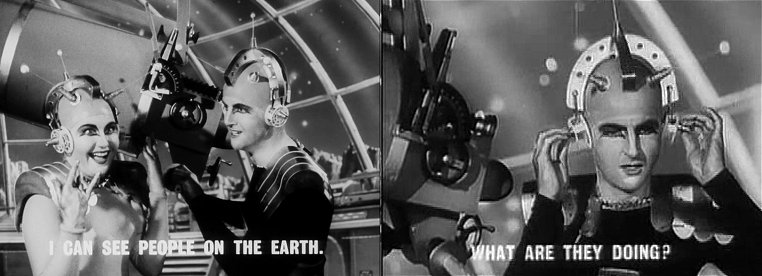
3 x 1 minute
film sequences
Producer:
Nicholas Parsons (uncredited) Script: Nicholas Parsons, David Ellis
(uncredited)
Director: Gerry Anderson (uncredited) Director of Photography: John
Read (uncredited)
Art Director: Reg Hill (uncredited) Cast: Nicholas Parsons, Denise
Bryer (uncredited)
Commercials
made for Nicholas Parsons' production company on behalf of Blue
Cars Holidays.
Also
made between the two series of Supercar. One of these, 'Martians',
won the Grand Prix prize in the
Commercial Services category at the first British TV Commercial
Awards in 1961, organised by the Television Mail.
A second one, the 'French' one, came third in the same category.
( Nicholas Parsons and wife Denise Bryer pictured )

1962 - Fireball XL5
An AP FILMS production
in association with ATV for ITC worldwide distribution


39 x b/w 30 min episodes First
transmitted: 28th October 1962
Produced by Gerry
Anderson
Set
in 2063, Steve Zodiac is the pilot of Fireball XL5, the flagship
of the fleet of the World Space Patrol, based in galaxy sector 25.
In his crew are the blonde, curiously un-surnamed space doctor Venus,
bespectacled Professor Matthew Matic, the transparent robot Robert
and alien 'pet' Zoonie the Lazoon.
The
first series to use the concept of a world class organisation combatting
evil and the first British children's television programme to be
taken up by an American network. Transmitted by NBC Television in
1962. This was the only show ever to contain a Gerry Anderson-voiced
character, albeit unrecognisable as Robert the robot! AP
FILMS were sold to Lew Grade at
ATV in 1962, prior to the production of Stingray and the studios
moved to larger premises at Stirling Road on the same estate.


May 1963 - Lyons Maid Ice Cream
Tie-Ins
'Zoom', 'Sea Jet',
'FAB', 'Super Sea Jet', 'Orbit' and 'Smash'
J.Lyons & Co.

April / May 1963 'Zoom'
was a 'Lyons Maid' ice rocket in three flavour stages: lime, lemon
and strawberry. It was one of the first lollies advertised on
television and in cinemas.
Lyons engaged Gerry Anderson to make the colour commercials, featuring
Fireball XL5 and Colonel Steve Zodiac, resulting in its becoming
a best-seller.
Thunderbirds and Joe90 were also later used to promote 'Zoom',
'Sea Jet and 'Super Sea Jet' lollies were also produced and a
number of advertisements starring Stingray were made to promote
the 'Sea-Jet' ice lolly.
'Sea Jet' was available in four flavours vanilla, strawberry,
lemon and orange. The 'Super Sea Jet' (which cost 2d. more) had
three flavours in one, mint and vanilla dipped in chocolate.
May 1967 saw the launch of the legendary 'FAB', with its
Thunderbirds and Lady Penelope tie-ins. Designed for girls in
the 5-15 age group, the 'hundreds and thousands' sprinkled
on top of a chocolate tip were intended to give it a feminine
and sophisticated look. The lolly itself consisted of strawberry
and vanilla ice with the top portion dipped in chocolate.
May 1968 'Orbit' was a rocket shaped lolly tied in to Captain
Scarlet and The Mysterons. It somewhat resembled 'Zoom' but was
chocolate and orange flavoured.
March 1969 A new range of 4d ice lollies were launched, called
'Smash', available in four flavours: orange, strawberry, banana/chocolate
and strawberry/vanilla.
Advertising was tied in to the Thunderbirds TV programme and the
launch was linked to a promotional camera offer.
The 'Super Sea Jet' was also re-launched in two versions: raspberry/orange
and strawberry/vanilla with a choc-dipped nose cone.
March 1972 'Zoom' relaunched as 'Super Zoom'
March 1976 'Space 1999' was launched at a price of 7p, a lime,
vanilla and strawberry flavoured lolly with a soft centre and
a picture card in each pack.
J.Lyons
& Co
 This
is a near complete collection of the original 1960's Supermarionation
commercials for Walls, Lyons Maid & Kellogg's. This
is a near complete collection of the original 1960's Supermarionation
commercials for Walls, Lyons Maid & Kellogg's.

1964 - Stingray
An AP FILMS production
in association with ATV for ITC worldwide distribution
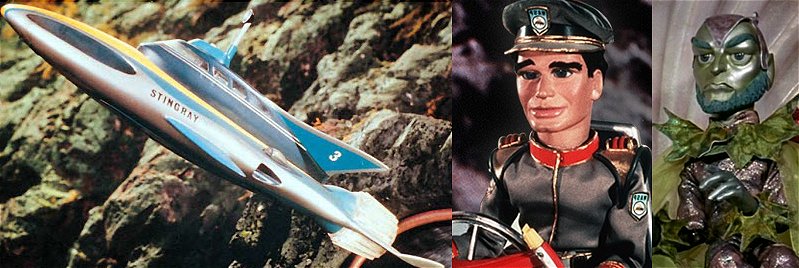
39 x colour 30 min episodes First
transmitted: 4th October 1964
Produced by Gerry
Anderson
Set
in the year 2064, Stingray, an advanced submarine belonging to W.A.S.P.
- the World Aquanaut Security Patrol - is crewed by pilot Troy Tempest
and hydrophones operator Lt. George 'Phones' Sheridan. They are
assisted by the underwater-breathing Marina, rescued from Titanica
by Troy in the first episode. Her father is Aphany, ruler of the
undersea kingdom of Pacifica. In between fighting the terror fish
of the evil Titan and his amphibians and outwitting their agent
X20, Troy is caught in the eternal triangle with the non-speaking
Marina and Atlanta, the daughter of Commander Shore, head of their
Marineville base.
Stingray
was the first series in which episodes were filmed simultaneously
by crews working on two completely separate soundstages with duplicated
sets and puppets. On Fireball XL5 the limited studio space meant
that the two crews shared the facilities on a single soundstage
and moved between the sets on a definite rota.
No
pilot episode was made for this series as it was directly ordered
by Lord Lew Grade. This was the
first children's series made entirely in colour ( for the
American market ), although 30 episodes of 'The Adventures of Sir
Lancelot' were made in colour in 1955. First shown on British TV
in black and white, the colour process used was christened ' Videcolor'.
Probably most remembered for the haunting end theme 'Aqua Marina',
a chart hit sung by Gary Miller and written by Barry
Gray.
'Stingray' was designed by Reg Hill.
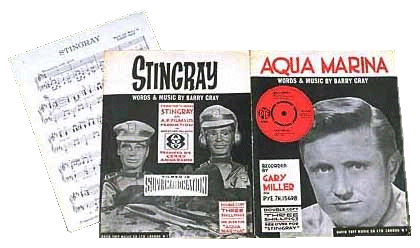

1965 - Thunderbirds (series 1 )
AP FILMS / ITC

Series 1 - 26 x 50 min
episodes First transmitted: Thursday 30th September
1965
Producer: Gerry
Anderson Associate Producer: Reg Hill

Set
in 2065, the Tracy family, operating from their secret Pacific Ocean
island base as International Rescue, save the world from disasters
of various sorts using the inventions of Hiram 'Brains' Hackenbacker.
Dad - Jeff Tracy - ex lunarnaut - is the boss and the various craft
are piloted by his sons Scott (TB1), Virgil (TB2), Alan (TB3), Gordon
(TB4) and John (TB5), with assistance at various times from their
faithful manservant Kurano and his daughter TinTin. Also helping
is their glamorous British agent, Lady Penelope Creighton-Ward and
her chauffeur Aloysius 'Nosey' Parker in the fabulous six-wheeled
pink Rolls-Royce FAB 1. Amongst their many problems is the master
criminal 'The Hood', who is constantly trying to discover their
secrets.
AP Films had been shooting episodes simultaneously
since Fireball XL5. Without this, a shooting schedule of two weeks
per episode would have taken 18 months to film Fireball XL5 and
another 18 months to film Stingray, whereas both series were actually
completed in half that time. For the 50 minute-long Thunderbirds
episodes the schedule for each was expanded to four weeks, but with
simultaneous shooting the first season 26 episodes were completed
in just over a year.
Thunderbirds
was not a success in America, which is why the show was cancelled
early and a new show commissioned. It was not shown in the U.S.A.
until 1968, after a greater success by Captain Scarlet.
The Tracy boys are all named after real-life astronauts. The pilot
episode 'Trapped in the sky' was only 25 minutes long but expanded
to 50 minutes on the orders of Lew
Grade.
This helped to improve the storyline and character development.
The 'Roller-road' was first conceived and used during the series
for ground vehicle motion shots.
Each episode of Thunderbirds contained, on average, 100 SFX shots.
This was also the first series not to be screened in a childrens'
TV slot.

1965 - Concorde
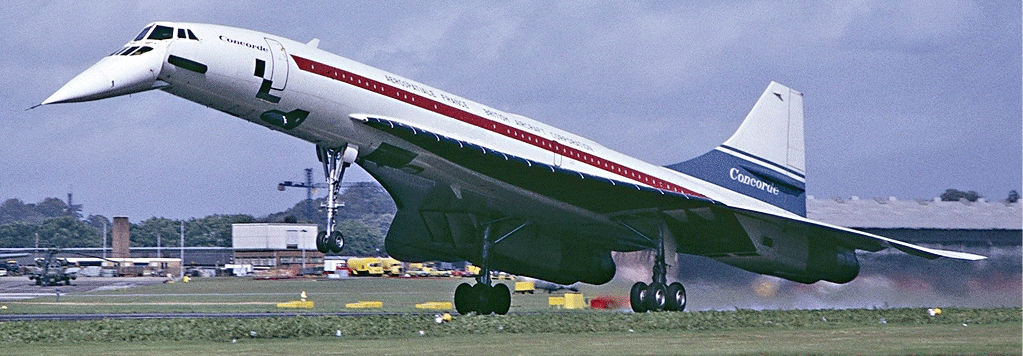
Footage
of a model Concorde taking off was produced for British Airways
to use in a documentary.
When the Concorde made its maiden flight to
Toulouse, France, to be unveiled, it was greeted by the
Band of the Royal Marines striking up Barry Gray's 'Thunderbirds
March'.
No
other information available.

1965
- TV Century 21 Paper and Century 21 Records
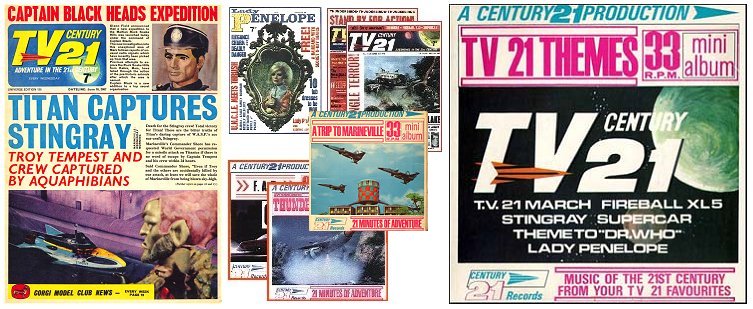 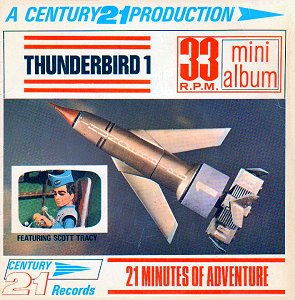
The year also
saw the launch of the high quality, glossy TV Century 21 comic on
Wednesday 23rd January. Published by City magazines and Century
21 publishing ( AP Films Merchandising ), it was conceived by Keith
Shackleton and edited by Alan Fennell, followed a year later by
a sister paper, 'Lady Penelope'. Combined circulation reached a
peak of 1.3 million copies per week.
Also launched, in September, was Century 21 records - Clive Selwood
and Gerry Anderson in partnership with PYE records. These 33 r.p.m.
mini albums - "21 minutes of adventure" - featured original material,
abridged versions of some of the shows and the wonderful music of
Barry Gray. 36 were produced in all:
1
x Fireball XL5, 3 x Stingray, 5 x Captain Scarlet, 4 x Theme and
Incidental music, 19 x Thunderbirds of which 3 were original new
stories. 4 others contained licensed properties including Doctor
Who and Topo Gigio

1966 - Thunderbirds Are Go
Century 21 Cinema
/ United Artists
 
Film
- 94 minutes
Premiered at The London Pavilion, Leicester Square, Monday 12th
December 1966
Executive
Producer: Gerry Anderson Producer: Sylvia Anderson

On
the big screen for the first time, International Rescue supervise
the security arrangements surrounding the launch of the 'ZERO X'
manned Mars mission. Problems arise when it runs into trouble on
the return journey.
Uniquely
features Cliff Richard and the Shadows in puppet form, performing
at the 'Swinging Star' night club which Alan Tracy and Tintin visit.
The puppets were stars at the premiere. This was the first attempt
by a British TV company to get into the cinema film business. The
film was actually called 'Thunderbirds Are Go' - no ! mark, which
can clearly be seen on the E.P.!
This is the official trailer of the first Thunderbirds movie featuring
the ZERO-X spaceship .

1966 - Thunderbirds ( series 2 )
AP FILMS / ITC
 
6
x 50 minute episodes First transmitted: October
2nd 1966
Producer:
Reg Hill
Executive
Producer: Gerry Anderson Associate Producer: John
Read

This
series - set in 2067 - brings us more action, adventure and bravery
from the Tracy boys and their expensive toys. Even more spectacular
special effects and strange mechanical devices. Thunderbird 3 was
apparently based on the Russian Soyuz craft. You may also note a
similarity in the shape of sections of the Tracy homestead and the
design of Thunderbird 5, their orbiting monitor station.
In
1966 Gerry Anderson received television's highest award,
The Silver Medal for Outstanding Artistic Achievement from
the Royal Television Society.

  
|
|
|
